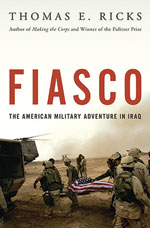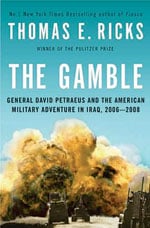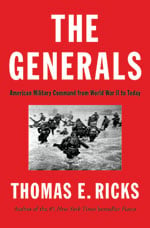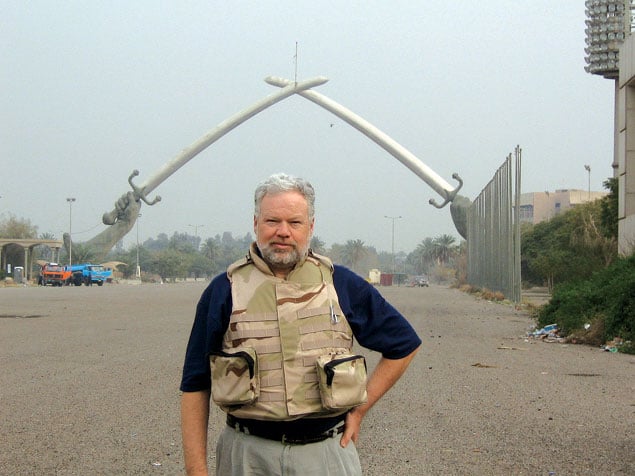Tom Ricks arrived in a parking lot outside Najaf, Iraq, at the
end of a 36-hour road trip that should have taken a third of that time.
The Washington Post reporter was riding along in a Humvee with
the Army’s 1st Infantry Division, reporting on the movement of thousands
of troops into the central Iraqi city, where Shiite militias had clashed
several times with US forces in previous weeks. It was April 2004, one
year into a war that Defense Secretary Donald Rumsfeld had doubted would
last more than five months.
During the journey to Najaf, the convoy was shot at with
rocket-propelled grenades and nearly blown up by a roadside bomb. “Don’t
be alarmed,” a 23-year-old sergeant told Ricks, then 48, as the soldier
calmly lit a cigarette, “but somebody here is trying to kill
us.”
The harrowing trek was part of the biggest Army operation in
central Iraq up to that point, and to Ricks it felt portentous. “The US
military operation in Iraq began to feel less like a troubled occupation
and more like a small war,” he wrote in the Post two days later.
Along with some other reporters, he was sensing what military leaders
refused to acknowledge: US forces were facing an insurgency, a campaign of
guerrilla warfare for which the military hadn’t trained and that the
American public hadn’t been told to expect.
“I had really known and admired the US military,” says Ricks,
who has worked the national-defense beat for a quarter century and whose
fifth book, a sweeping review of wartime leadership called The
Generals, comes out this month. “But what was going on in Iraq was
not what I expected.”
The mightiest military in the world found itself literally
mired in mud, stuck in traffic during interminable convoys, shot at by
insurgents hiding in palm groves, and unable to cross bridges that had
been blown up in their advance.
“Jesus,” Ricks remembers thinking. “I’m going to be chained to
Iraq for the remainder of my life in journalism.”
From Najaf, Ricks called his wife. “I just thought you should
know we were bombed tonight,” he told her.
There was something he needed to know, too, she said. That
night, at the same moment the missiles and the rockets were flying,
Ricks’s father had died of a heart attack.
“It was a moment of departure for me,” Ricks says, a confluence
of life-rattling events that permanently altered his perception of the war
and his role in it.
Ricks sat down and wrote, something he does every day, but with
a new urgency. He tapped out an e-mail to Scott Moyers, the editor who was
working with Ricks on a yet-unnamed book about the spiraling Iraq War.
“Scott,” he wrote, “I have a title: Fiasco.”
• • •
Published 27 months later, in July 2006, Fiasco: The
American Military Adventure in Iraq arrived at an opportune moment. A
battle-weary public was primed to hear Ricks’s unsettling message that the
United States was in danger of losing the war.
“The title of this devastating new book . . . says it all,”
the New York Times wrote in its review. Ricks “serves up his
portrait of [the Iraq] war as a misguided exercise in hubris, incompetence
and folly with a wealth of detail and evidence that is both staggeringly
vivid and persuasive.”
Fiasco shook the military and political
establishments. Word went out among some top officials that they should
avoid talking to Ricks lest they end up a character in an unflattering
sequel. It was a blistering indictment, perhaps the strongest of a short
list of books published around the same time that offered grim assessments
of the war.
But Ricks also pointed to solutions, even saviors. He praised
General David Petraeus, then in charge of the Army Command and General
Staff College at Fort Leavenworth, Kansas, for requiring that the
long-overlooked military theory of counterinsurgency be taught to all
midcareer officers. COIN, as it’s often called, prizes civic engagement
and street-level diplomacy over violent fighting to control territory. The
key to victory is to protect and win over the population, defeating
insurgents not by killing them but by making them irrelevant.
More than any other chronicler of the Iraq War, Ricks brought
COIN to its zenith of influence and credibility in Washington, where
policymakers were desperate for some antidote to the blood-filled slog in
Iraq. Ricks’s book, and later his blog, the Best Defense, became prominent
showcases for COIN theory.
COIN was a gateway for Ricks, the crossover between
dispassionate reporting and writing with a clear point of view. He was
leaving the ostensibly neutral terrain of journalism for a realm in which
he began influencing the same policies and people he’d spent his career
writing about.
“He joined the community he once covered,” says Michèle
Flournoy, a former senior Pentagon official who cofounded the Center for a
New American Security, a think tank that became the COIN brain trust and
where Ricks is now a senior fellow.
On his blog and in newspaper op-eds, Ricks has launched a
frontal assault on cherished pillars of military culture. He has called on
the services to close their prestigious academies and use the savings to
fund college ROTC programs. He has argued in favor of reinstating the
draft.
“The whole Pentagon reads his blog,” says Kurt Campbell, an
assistant secretary of State and former Pentagon official. Ricks has
invited guest posts from experts. Petraeus has been among the blog’s
commenters.
In all Ricks’s work, there is both a writerly verve and an
empathy for the grunt, the human being inside the boots on the ground.
When senior Pentagon officials read Ricks, it may be at least in part
because he’s more in touch with the troops than they are.
• • •
Ricks was introduced to COIN by a retired intelligence officer
named Terry Daly, who suggested that he pick up a copy of the movement’s
seminal text, Counterinsurgency Warfare: Theory and Practice by
David Galula, a retired French colonel who fought in the Algerian War.
It’s the most concise explication of COIN’s core values, based on Galula’s
own battles with insurgents. But it was nearly forgotten by military
historians after its publication in 1964, three years before Galula
died.
Ricks was deeply impressed by the book; he compared Galula to
the revered Prussian military thinker Carl von Clausewitz. Ricks began
recommending the book to an exclusive, off-the-record listserv of
academics, policymakers, and military journalists called the Warlord Loop.
His posts caught the attention of John Nagl, a young Army officer who
would go on to be one of COIN’s most visible proponents.
“I’m embarrassed that I hadn’t read Galula until 2005, when Tom
mentioned it,” Nagl says. Daly was also encouraging members of the Warlord
Loop to study Galula’s work.
In 2006, Nagl joined a committee of experts and scholars
convened by Petraeus to write a new edition of The U.S.
Army/Marine Corps Counterinsurgency Field Manual. The updated
document was infused with Galula’s principles.
In Washington, President George W. Bush and Pentagon leaders
were searching for a new plan of attack. They turned to Petraeus, who had
already held two commands in Iraq, and his dusted-off theories about how
to win a war. In January 2007, Bush announced a “surge” of 20,000
additional troops. Petraeus was put in charge of all US forces, leading
them in battle under the COIN banner.
The field manual made momentary celebrities of its coauthors,
dubbed COIN-dinistas in the press. In August, Nagl appeared in uniform on
The Daily Show With Jon Stewart to discuss the book and the new
way forward in Iraq. A few months later, some of his fellow writers, until
then mostly unknown outside the rarefied zone of military policy, appeared
on Charlie Rose. Petraeus’s followers had a rare combination of
combat experience and doctoral degrees, and they lent immediate
credibility to the new strategy. The manual was posted to the Internet,
and more than 2 million copies were downloaded in two months.
It was remarkable enough that a complex military text based on
an overlooked treatise by a dead French officer sparked a national
conversation about war-fighting on late-night talk shows. But more
important, COIN became the idea upon which hopes for an honorable American
exit from Iraq were pinned. If not for Ricks, it might never have caught
on.
“Ricks brought Galula to a mainstream audience,” says Nagl.
“Repopularizing Galula really was a key idea that underlay the
counterinsurgency insurgency.”
Ricks’s break with traditional journalism was probably
inevitable. For most of his career, which included 17 years at the
Wall Street Journal and earned him two shared Pulitzer Prizes, he
felt hemmed in by what he calls the “bloodless” style of newspaper
writing. A disapproving editor, he says, once admonished him about proper
form in an article.
“Tom, your story doesn’t have a Washington Post
lead.”
Ricks replied, “Thank you.”
Ricks’s War Chronicles

2006
Ricks paints a bleak picture of the Iraq War. The book is published as public support for the war is beginning to wane.

2009
The author praises General David Petraeus and argues for the use of counterinsurgency strategies in Iraq.

2012
Ricks studies nearly 80 years of Army decision-making to explore the theme of accountability of leadership.
Ricks was born in Massachusetts in 1955 and grew up in New York
and Afghanistan, where his father, a professor, worked for two years in
Kabul. Ricks spent his early teenage years riding buses from town to town,
learning enough Farsi to hold a conversation and trying to visit every
Afghan city with a population over 5,000. He says he made it to all but
one.
Ricks and his wife, Mary Kay—also an author—have two adult
children and split their time between a home on Capitol Hill and one on an
island off the coast of Maine. Ricks says that when he was writing
Fiasco, he rented a house in Maine for three weeks and found that
in the remote setting he was especially prolific: “I was writing like a
monkey.” He rented a house again while writing another book. His wife told
him that for the money they were spending on vacation rentals, they might
as well buy a house there.
Ricks left the Washington Post at the end of
2008 after eight years. He’d been thinking of quitting to write books
full-time, and when the paper offered buyouts, he says, “I leapt at it.
Going to the Post was one of the best decisions I ever made.
Leaving it when I did was another good decision.”
Ricks had chafed at the newspaper bureaucracy, and he was
disappointed by editors who resisted embracing the Internet as a new
opportunity for publishing. “The newspaper business model was optimized
for 1920,” Ricks says. “My frustration with the utter failure of
newspapers to really recognize how the world was changing sensitized me to
failures in the military.”
He started blogging soon after he left. His former editor,
Susan Glasser, had taken over as editor-in-chief at Foreign
Policy magazine, which the Post had bought. She asked Ricks
if he’d like to reprise a feature she had overseen for the paper’s Outlook
section, called Tom Ricks’s Inbox, which gave readers snippets of e-mail
conversations Ricks was having with sources and experts about the wars in
Iraq and Afghanistan. Ricks’s blog, the Best Defense, drew an audience of
high-level officials and influential thinkers and won a National Magazine
Award in 2010.
In 2009, Ricks came out with his follow-up to Fiasco.
With The Gamble: General David Petraeus and the American Military
Adventure in Iraq, 2006-2008, he started making predictions. In
speeches and on TV and radio, he said that American troops would be in
Iraq for another ten years. And he took sides. Petraeus was cast as a hero
of the war effort, aided by his COINdinista acolytes.
Ricks sometimes hands his blog over to guest posters who are
critical of his work and of COIN. Others have faulted him for giving
inordinate weight to the strategy, which they say hadn’t been sufficiently
studied or tested in war. Recently, new figures that weren’t available
during the Iraq surge have raised doubts about whether an influx of troops
and COIN principles was what caused the drop in violence in 2007 that
paved the road to an American exit. Scholars now question whether other
events, such as Sunni tribal leaders’ siding with US forces in a mutual
struggle against al-Qaeda, had a bigger effect.
Critics also argue that COIN theory, as described by its
proponents, was never actually implemented in Iraq, nor has it been in
Afghanistan. The military strategy in those countries has drawn on some
core counterinsurgency principles, but US troop levels have been too low
to sustain the kind of broad civil pacification that Galula saw as key to
winning hearts and minds. The US military strategy also didn’t eschew
violence; many of the significant strategic victories against insurgents
were the result of targeted operations to kill key members.
Ricks has said the Iraq surge failed to change the political
dynamics in that country, and now he says the increase in troops was the
“least important” military factor in Iraq. As for COIN, he looks back with
a remarkably different view.
“I think it became a convenient handle for everyone to pile on
about how we should change what we’re doing in Iraq,” Ricks says, not
exempting himself or anything he wrote. “I think COIN was a very good
tactic for what Petraeus was trying to do in Iraq, which was to extract us
with dignity, which he did. Now COIN isn’t the flavor of the month, but it
worked for the time.”
Blogs such as Ricks’s have provided a forum for hashing out
competing theories of war-fighting. That has been a vital exercise, but it
has also produced some half-baked theories.
“The Internet has opened the door for vacuous but cute, concise
ideas to lead the debate,” says Celeste Ward Gventer, a former senior
Pentagon official who served two tours in Iraq and provided policy advice
on reconstruction and counterinsurgency to defense policymakers. “[Ricks
is] part of that story because he was one of the people who pushed these
ideas that hadn’t been sufficiently vetted and explored by scholars.”
Washington shares the blame, too, she says. “It’s an unbelievably faddish
town, and COIN was the fad to end all fads.”
But in Iraq in 2006, the military urgently needed to change
course.
“The middle of a war is not the time to sit and wait for proper
academic studies to be conducted,” Ricks says. “I know of no evidence that
academics were studying whether counterinsurgency could be applied in Iraq
until outsiders began urging people to do it. Can you imagine someone
saying that we needed to do an academic study of whether D-Day would
work?”
Ricks doesn’t call himself a historian. Although his latest
book, The Generals, scrutinizes nearly eight decades of Army
decision-making, it’s not precisely a work of scholarship. He uses the
tools of reporting and storytelling to explore a theme that infuses much
of his writing: accountability of leadership. Who’s in charge of a war
matters. But mistakes shouldn’t spell the end of a career. The best
generals learn from them.
Writers are no different.
“I was wrong about the troops in Iraq,” Ricks says. “I thought
we’d have them there for many years to come.” In 2009, when President
Obama was announcing his plans to withdraw US forces, Ricks was one of the
most prominent skeptics; he said American servicemembers would be in Iraq
at least another five years, possibly ten. The last troops left on
December 18, 2011.
“I think I was also overly pessimistic about what would happen
in Iraq when we left,” he says. In 2009, he warned that the country would
fall apart absent an occupying US force. Today he thinks Iraq still hasn’t
solved its long-term problems, but it’s more stable than he had
predicted.
“It has chastened me, being wrong,” he says. “But there’s a
responsibility to make predictions, to say, ‘Here’s where I think things
could lead.’ ” It’s as though, for Ricks, the price of dropping the mask
of journalistic objectivity is never again to hide his true
face.
It turns out that the 25 years he spent working for newspapers
were a prelude to the job he really wanted all along. “I was a writer
trying to be a journalist,” Ricks says. “But now I’m a writer. It feels
like I’m home, like I’ve come into port.”
Senior writer Shane Harris (sharris@washingtonian.com) is winner of the 2010 Gerald R. Ford Prize for Distinguished Reporting on National Defense.
This article appears in the November 2012 issue of The Washingtonian.


















